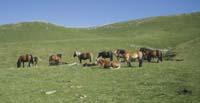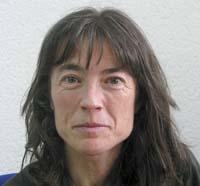Livestock in pasture

Quality is more important in extensive livestock than quantity. This is one of the objectives of this livestock: to achieve a balanced production of quality food. To do this, herders and ranchers graze livestock outdoors, in high mountain pastures, from spring to autumn, exploiting natural resources.
This type of livestock has numerous advantages, as reported by the professor of Plant Biology and Ecology of the UPV, Arantza Aldezabal. In fact, cattle are able to create a certain diversity at different temporal and spatial scales. "If I hadn't won, we wouldn't have the mosaic landscape we have today on the mountain," adds Aldezabal. They have also observed that, in general, the influence of average or low livestock loads is quite positive, since they increase diversity in plant communities or pastures. That is, cattle create a balance in the competition between species. Grazing highly competitive species, it takes away some strength and allows others to grow.
On the other hand, “in the extensive livestock system, if we combine several species of livestock, at the same time we diversify the use or use of pastures”, explains Aldezabal. Each animal has a different strategy to eat.
For example, large animals, like cows, need a lot of grass. But reflective cows cannot eat all day long. They will have to reflect to process the food. In this process the stomach is full and they can eat no more until the reflection ends. "Therefore, cows look for a type of herb that provides them with a large biomass in each bite. In addition, they are able to digest the grass with a lot of fiber," says Aldezabal. "Mares, on the other hand, are not ruminants and therefore eat much of the day. And sheep look for more herbs than others that provide protein. Therefore, spatial segregation occurs and the overexploitation of one type of plant and the exclusion of another is avoided," he adds.
In addition, as for the physiology of plants, they have seen that they are able physiologically to model and control their vital strategy so that grazing causes them the least possible damage. "Without a doubt, the extensive livestock system is an interactive system," says Aldezabal.

Incorrect management
However, each area has a resistance capacity, that is, with what it produces is able to maintain a certain number of animals without harming that production for a certain time. What happens when this resilience is exceeded? Cattle start to cause damage. Excess grazing can harm the reproduction of plants, as it leaves no seed for the following year; treading can produce clearings that, at times, have been occupied by invasive plants or fast colonizers. Pasture is also destroyed, reducing species diversity.
The key is to keep the livestock load in the right dimensions to enjoy all these advantages of extensive livestock. On the contrary, inadequate management only causes damage. Proof of this is the case of Cantabria. Formerly they grew their own breed of beef Tudanka for meat. This breed is well adapted to the medium, needs little handling... But it does not produce much meat. Thus, farmers have bought and grazed foreign breeds, with better meat qualities and more meat. And they have seen that local and foreign breeds make a different use of pastures. These foreign breeds have been concentrating only on areas of soft and clean grass, overexploiting these pastures leaving the ground bare.
As a result, a species of vegetation that has historically been controlled in these pastures, the polygalifolia Euphorbia, has grown and increased considerably. This species is toxic to cows and is totally rejected. But it does not harm the sheep, so "with the sheep it would be possible to control this invasion" says Aldezabal... Therefore, the strategy they propose to deal with this plant is to play with sheep.

"In the CAPV we have conducted some experiments to use livestock as a management tool, but the idea has not yet been incorporated by farmers and pastoralists. And in the area of Aralar and Aizkorri, for example, extensive livestock is practiced, especially by custom", added Aldezabal.
"The shepherds of Aralar are, on average, much younger than those of other places. In these environments this profession is still very strong," said Aldezabal. However, the data indicate that there are fewer and fewer farmers and pastoralists in general, and that the average age of them is quite high to maintain the profession in the future.






